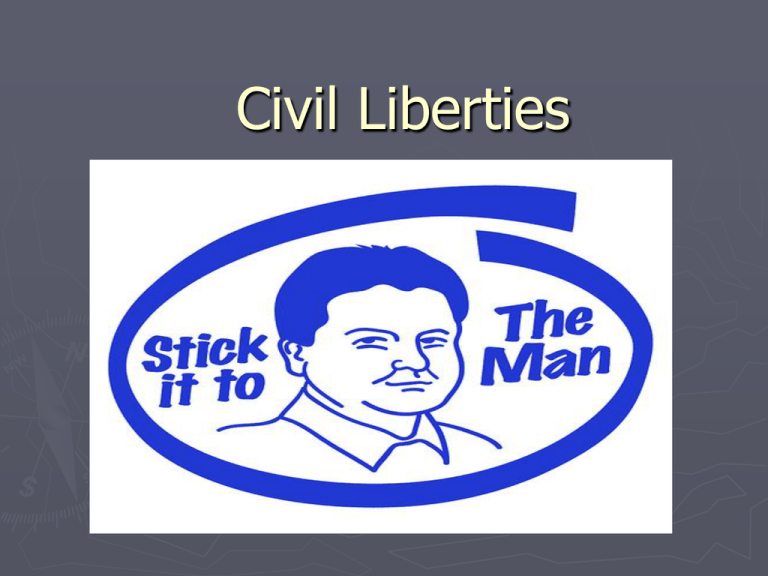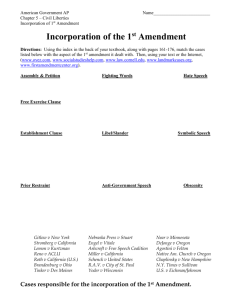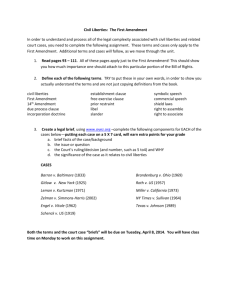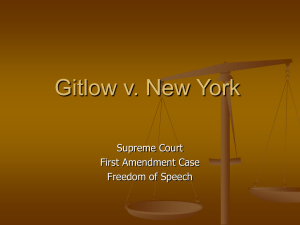File - Coach Wilkinson's AP Government Class
advertisement

Civil Liberties Sticking it to the Man Civil Liberties ► PERSONAL rights and freedoms that can not be abridged either by law, constitution, or judicial interpretation. “Unalienable Rights” Birth of the Bill of Rights ► It was apparent that without an article directly speaking to the Bill of Rights the Constitution would not be ratified. Federalists vs. AntiFederalists ► Federalist 84- Bill of Rights “Unnecessary and Dangerous” ► Anti-Federalists win and Bill of Rights 1791 Dual Citizenship ► Bill of Rights was designed to limit the powers of the National Government. Barron vs. Baltimore 1833(Supreme Court Supported the Idea) ►Courts ruled that the Bill of Rights only applied to the national government and not the state. “Each state established a constitution for itself” and had its own bill of rights. Citizens in different states essentially had different sets of civil rights. Incorporation ► 14th Amendment not only defined citizenship but placed Restrictions on the State Government “NO STATE SHALL…” It was not until the 14th Amendment was ratified in 1868 that civil liberties guaranteed by the national Constitution began to be applied to the states. Gitlow v. New York ► There was no question that that 14th amendment applied to the state governments. However, courts were hesitant to define the liberties spelled out in the BOR as constituting “due process of law” which was protected under the 14th amendment. ► Gitlow was thrown in jail for advocating an overthrow of the New York Government Gitlow was thrown in jail because he violated the New York anarchism crime ► Gitlow’s lawyers argued his freedom of speech was being abridged… The Supreme Court held that the 14th amendment applied one of the protections of the first amendment, freedom of speech, to the states. ► USING INCORPORATION THE 14th AMENDMENT TO APPLY THE BILL OF RIGHTS TO THE STATES ON A CASE BY CASE BASIS Tool used in incorporation is the 14th AMENDMENT Does this mean that all of the Bill of Rights were restored to the states?!?!?! Only gradually and never completely did the SC accept incorporation theory. ►The view that most of the protections of the BOR are incorporated into the 14th amendment’s protection against state government actions. More Incorporation Cases See chart in textbook on page 97 for all the incorporation cases ► Near v. Minnesota ► INCOROPORATED FREEDOM OF PRESS ► Dejonge v. Oregon ► INCORPORATED THE FREEDOM TO ASSEMBLE First Amendment Guarantees ► Freedom of Religion The Establishment Clause ►Prohibits the government from establishing a national religion ►Thomas Jefferson Called it “Wall of Separation” Establishment Clause ► ► This clause is applied to all conflicts about such matters as the legality of the state and local governments aid to religious orgs and schools, school prayers, teaching of evolution, 10 commandments in school and discrimination School Prayer Engel vs. Vitale- NY schools implementing prayer at the beginning of each day. ►Struck down Non-Denominational Prayer Abington School District v Schempp- Struck down officially sponsored daily readings of the Bible and recitation of the Lord’s prayer. Establishment Clause ► ► 1971- Lemon vs. Kurtzman ruled that direct state aid could not be used to subsidize religious instruction. How can the Courts tell what is religious in schools or what is secular? Lemon Test ►Have a Secular Purpose ►Have a primary effect that neither advances or prohibits religion ►Not foster excessive government entanglement with Religion This lemon test has been applied in most cases under the establishment clause since 1971 Free Exercise Clause ► “Congress shall make no law… prohibiting the free exercise” However this clause is also open to interpretation. Several Religious Practices have been ruled as unconstitutional including Reynolds vs. United States ►Polygamy is illegal and thus not covered under the Free Exercise Clause Oregon vs. Smith ►Banned illegal Drug use in Religious ceremonies. Free exercise clause does not cover illegal acts Quiz ► Define incorporation ► What was the first case of incorporation ► What was the constitutional tool of incorporation? ► What clause in the Freedom of Religion did Jefferson call the “Wall of Separation” ► What court case said the Bill of Rights only applies to the federal government? ► Limits of the Freedom of Press Prior Restraint- (restraining an action before it has occurred, when expression is involved this is censorship. New York Times vs. United States ►Prior Restraint is unconstitutional unless it presents a clear and present danger to our nation ►Wiki leaks? Freedom of Speech ► ► ► Schenck vs. U.S. “Clear and Present Danger”- expression may be restricted if evidence exists that such expression would cause a condition, actual or imminent that Congress has the power to prevent. New York Times v. Sullivan Established Libel and Slander ►Any speech with “malice intent” to harm is not protected under the first amendment Roth v. United States Obscenity is not protected by the first amendment Freedom of Speech Miller vs. California- obscenity ►Community Standards Test ►The work taken as a whole appeals to a prurient interest in sex. ►The work shoes patently offensive sexual conduct ►The work lacks serious redeeming literary, artistic, political or scientific merit. ►“I KNOW IT WHEN I SEE IT” Freedom of Expression Penn and Tellar- West Wing Clip ► NOT DIRECTLY STATED IN THE FIRST AMENDMENT!!!!!!!!!! Texas v. Johnson ►Flag burning is protected under the 1st amendment because expression is a form of speech. ►Congress than passed the Flag PROTECTION Act in 1989 which was ruled unconstitutional in 1990 by the SC Quiz ► Define Incorporation ► What are the 2 clauses in the freedom of religion ► What court case limits your speech if it presents a clear and present danger to those around you ► What court case says school prayer is unconstitutional ► What was the first case of incorporation? 1st Amendment at School ► “Students do not shed their constitutional rights when they enter the schoolhouse door." Tinker vs. Des Moines Alright to wear a black armband to protest the Vietnam war MORSE et al. v. FREDERICK Upheld the suspension of the “Bong Hits 4 Jesus” culprit, can’t promote drugs at school Hazelwood vs. Kuhlmeier ►Administration has Prior Restraint Right to Assemble and Petition ► National Socialist Party of America vs. Skokie Nazi’s could march Recently Westboro Baptist Church has been an issue, demonstrating at soldier’s funerals. SC ruled in the church’s favor in Snyder v. Phelps. nd 2 ► and rd 3 Amendments Have not been incorporated Selective incorporation allows for fundamental rights to be granted to all citizens. The right to bear arms or quarter soldiers are not fundamental rights Rights of the Accused ► ► ► Criminals suspects have the right to due process and fair treatment. Gideon vs. Wainwright 1963- an attorney must be provided at the government’s expense if the accused of a felony can’t afford it. Miranda v. Arizona (1966)- Miranda admitted to raping and kidnapping a woman after 2 hours of questioning, lawyer argued the police never informed him of his right to remain silent and have counsel. Court ruled in Miranda’s favor creating the Miranda rights. There is the public safety exception to this rule, the need to protect the public warrants the admittance of the statements. CHART IN BOOK ON 123 4th Amendment ► Unreasonable Search and Seizure Mapp v. Ohio ►Overturned Wolf v. Colorado ►Incorporated the Exclusionary Rule Anything obtained in an illegal search and seizure may not be used at a trial Katz v. United States ►Wiretapping amendment without a warrant violates the 4th 5th Amendment ► Indictment by a grand jury, self incrimination, double jeopardy, and eminent domain Miranda vs. Arizona ►Miranda Rights Kelo vs. City of New London ►The government can take public property to give to private companies Quiz ► Define incorporation ► Define the exclusionary rule ► List the two clauses in the Freedom of Religion ► What court case incorporates your right to be free from Self Incrimination ► What court case establishes the clear and present danger doctrine? 6th Amendment ► Right to a Speedy and public trial, Right to a lawyer Gideon vs. Wainwright ►Right to an attorney during the trial Escobedo vs. Illinois ►Right to have a lawyer present during police interrogation 8th Amendment ► Cruel and Unusual Punishment Furman v GA (1972)- imposition of the death penalty has been random and arbitrary and applied thusly violates the 8th and 14th amendment, but not necessarily of the criminal has killed or attempted to kill someone. States were invited to enact more precise laws so the DP could be applied more consistently. Gregg v. Georgia ► GA and other states adopted a bifurcated or two stage procedure for capital cases in which in stage one the jury determines innocence or guilt and then meets later to determine if the DP is applicable. SC agrees under this that Death Penalty is NOT cruel and unusual punishment Diagram in book on 129 ► No Right to Privacy? Constitutional Right to Privacy However, the courts have used several amendments to “interpret” a right to privacy Griswold vs. Connecticut ►Law was passed in Connecticut banning the dissemination of information about the sale of Contraceptives Courts ruled the law was Unconstitutional based on Amendments 1,3,4,9,and 14 Establishes the RIGHT TO PRIVACY Roe v. Wade ► Argued that the decision to carry a pregnancy to term was a Women’s fundamental right In Roe v. Wade, the court found it was a fundamental right of a woman to have an abortion. ►Used right to privacy and primarily the 9th amendment to reach their conclusion ►Ever since Conservative justices have been trying to overturn Roe vs. Wade The Right to Die ► Cruzan v. Missouri Dept of Health (1990) Living will is legitimate Only if the patients family is able to provide “ Clear and convincing evidence” like a living will 9th Amendment





